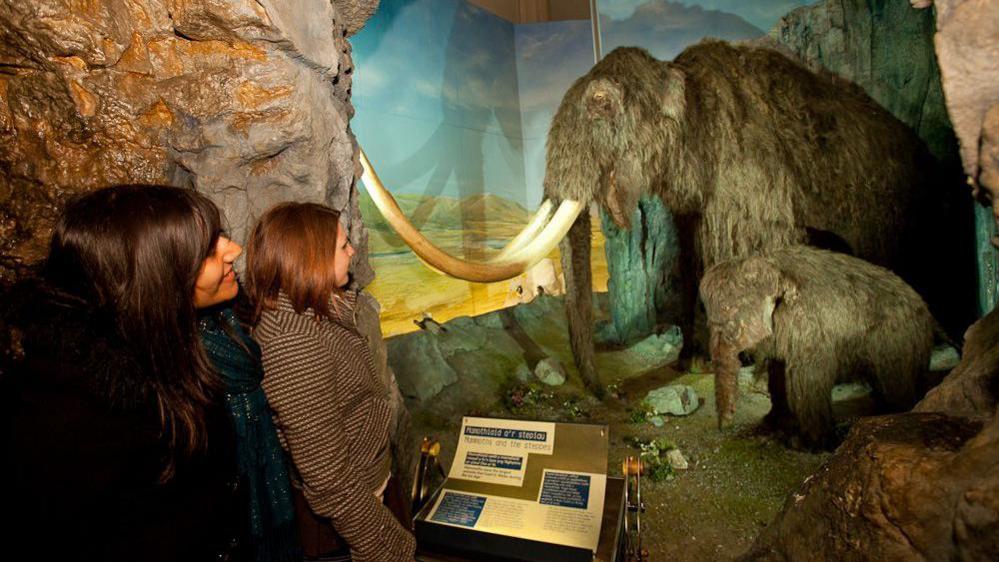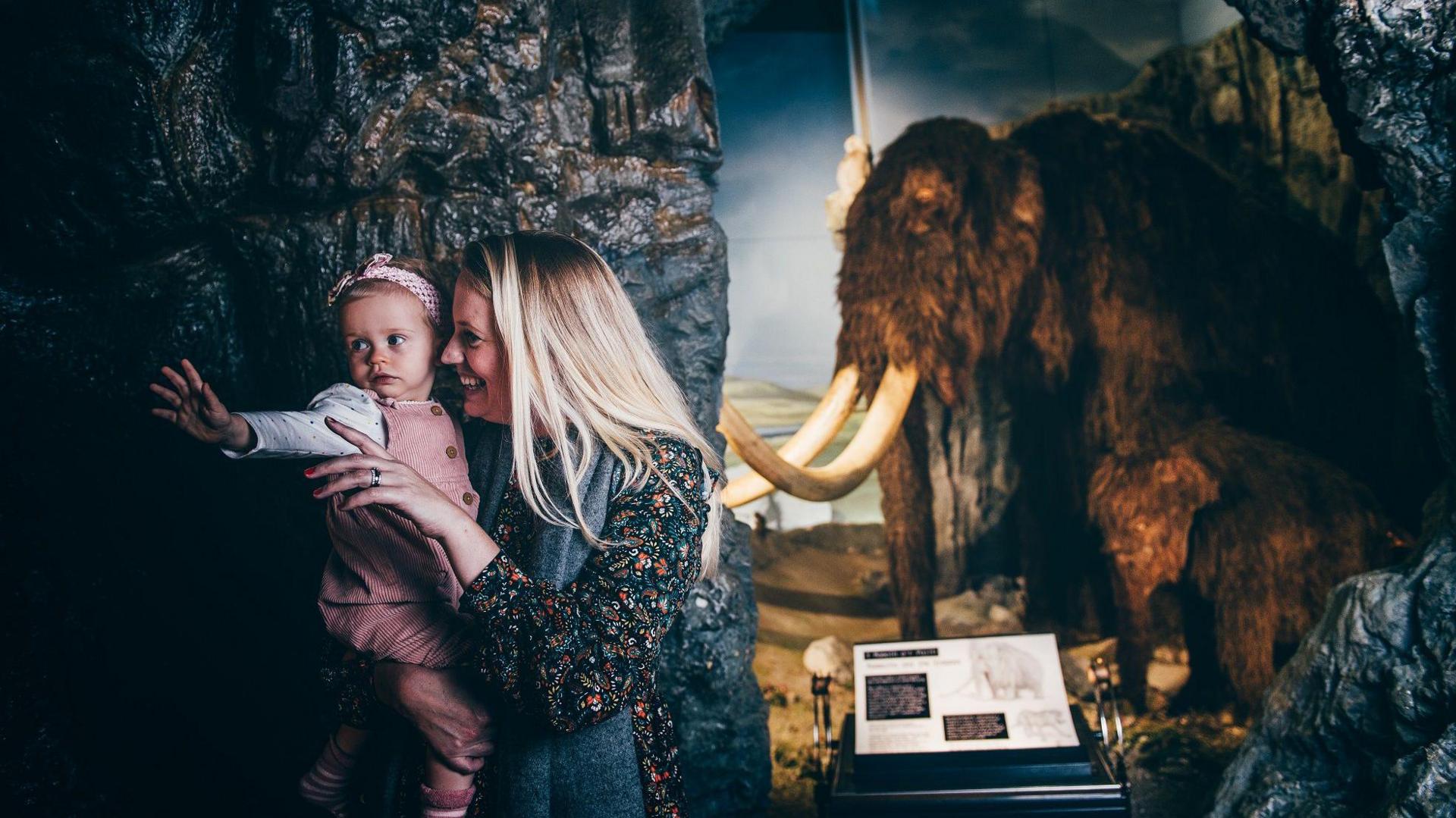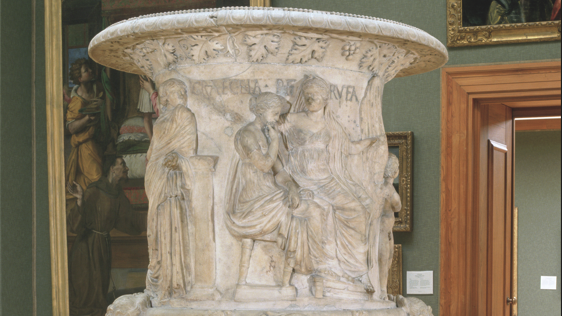The seven wonders of Wales' national museum

The woolly mammoth exhibit is one of the most well-known displays at the National Museum
- Published
You may have several fond memories of the National Museum if you've lived in or visited Cardiff.
Many rainy days will have been rescued by wandering around the exhibitions and artwork on display at the museum, ending with an obligatory trip to the gift shop.
But questions have been raised about the future of the museum as it struggles for funding.
It is home to many fascinating pieces, some more well-known than others. But how well do you know them?
The woolly mammoths exhibit

The woolly mammoths exhibition has been at the National Museum since 1991
In December 1991, a mechanical mother and baby woolly mammoth arrived as part of the mammoths and ice exhibit.
The exhibition, which borrowed specimens from across Europe, focused on animals that once lived in Wales.
Alongside the two mammoths were a woolly rhinoceros, giant deer, hyena, hippopotamus and a cave bear.
The mother and baby model remain one of the most popular displays at the museum today.
Lily's fossil footprint

The fossil footprint, pictured next to a pound coin, was discovered by four-year-old Lily in 2021
Four-year-old Lily made national news in 2021 after stumbling across a 220-million-year-old fossil during a trip to the beach.
Lily, from Barry, Vale of Glamorgan, found the footprint at Bendrick’s Bay while walking with her dad.
The footprint, which belongs to an unknown herbivorous dinosaur from the Upper Triassic period, was extracted and can now on show for all to see.
Van Gogh's self portrait

The self-portrait can be viewed at the National Museum in Cardiff until 24 January 2025
Just last month, the 1887 self portrait by renowned Dutch artist Vincent van Gogh was unveiled as part of the art of the selfie exhibition.
Arguably one of the most prolific selfie takers of his time, Van Gogh painted a total of 35 self portraits during his lifetime.
It is believed this was because he couldn’t afford to hire a model.
The portrait has been loaned to the museum from Musée D’Orsay in Paris as part of an exchange and can be viewed until 24 January 2025.
The iron meteorite

The meteorite is the oldest artefact at the museum at 4.56 billion years old
Do you know what the oldest artefact at the museum is?
It’s an iron meteorite from Nambia which is 4.56 billion years old.
The meteorite, which weighs 260kg, is part of a collection of 77 meteorites from locations around the world.
The Welsh dinosaur

The Dracoraptor hangani is the Welsh cousin of the Tyrannosaurus Rex
In 2014, brothers Nick and Rob Hanigan discovered the bones of a 200-million-year-old dinosaur on Lavernock beach, Penarth.
The dinosaur, named Dracoraptor hangani after the two brothers, is the Welsh cousin of the Tyrannosaurus Rex.
The bones of the dinosaur can be found in the museum along with a life-sized reconstruction, created by Bristol-based artist Bob Nicholls.
The Jenkins vase

The Jenkins vase originated in Naples in 1489
The Jenkins vase began its life as a round Roman altar from Naples in 1489.
It was transformed into a vase in the 18th Century and a drawing in the British Museum shows what it looked like before.
It is thought that Thomas Jenkins, a painter, banker, and dealer in classical antiquities based in Rome, bought the vase in Naples in 1769.
The vase shows the marriage of Paris, son of Priam of Troy, to Helen.
Reframing Picton

The Reframing Picton project began in 2020, during the Black Lives Matter protests
A portrait of Sir Thomas Picton was removed from the museum in November 2021 as part of a Reframing Picton project and put in storage.
It came at a time of heightened scrutiny of memorials to slave owners.
But the portrait was put back on display after the museum commissioned two artworks from Trinidadian artists to accompany the piece, reframing Picton’s legacy and providing a voice to his victims.
Who were the Davies sisters?

Three of Monet’s waterlilies paintings were bequeathed to the museum from the Davies sisters' collection
After gathering one of the greatest art collections of the 20th Century, two sisters "transformed" the museum's exhibits by donating 260 pieces of art.
Gwendoline and Margaret Davies started collecting artwork in 1908 and gathered a vast array of pieces during their lifetime.
When they died in 1951 and 1963 respectively, the two sisters bequeathed their collection to the museum.
Some of the most notable works in their collection include Van Gogh’s Rain at Auvers, three of Monet’s waterlilies paintings, Renoir’s La Parisienne, two paintings by Botticelli and five oil paintings by Turner.

Experts originally dismissed Botticelli's painting of the Madonna as a copy
Monet's 1905 Waterlilies painting is just one of the paintings donated from the sister's collection to the museum.
Another piece on display is Botticelli’s Virgin and Child with a pomegranate.
Initially, experts dismissed the painting of the Madonna as a copy.
In 2019, the BBC Four programme Britain’s Lost Masterpieces confirmed the painting was genuine after they found a small doodle believed to be by Botticelli.
After years of doubt, the painting was finally put on display in the museum.
The sister's legacy continues through a charity dedicated to providing grants for the arts, education, health, and social causes.
Their legacy also lives on inside the walls of the National Museum through the donated art which has, according to the museum, "completely transformed its art collection in character, quality and range".